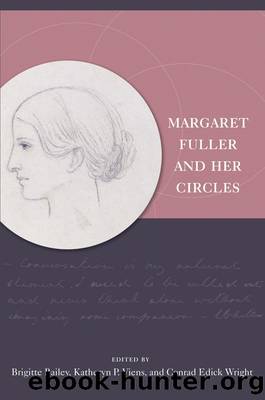Margaret Fuller and her Circles by Brigitte Bailey Katheryn P. Viens & Conrad Edick Wright

Author:Brigitte Bailey, Katheryn P. Viens, & Conrad Edick Wright
Language: eng
Format: epub
Publisher: University of New Hampshire Press
8
SYMPATHY AND PROPHECY
The Two Faces of Social Justice in Fullerâs New York Writing
Jeffrey Steele
When Margaret Fuller moved from Massachusetts to New York City at the end of 1844, this transition pushed her to a new stage of literary awareness. The deep fault lines of the city made her acutely aware of the ways in which earlier modes of Transcendentalist analysis, focused upon the reform of the self, were an inadequate vehicle to diagnose what seemed like a pervasive social injustice. Like her predecessor Lydia Maria Child, Fuller saw around her an acquiescence to slavery, a widespread materialism, and a general insensitivity to the poorer and weaker members of society. For many of Fullerâs middle-class contemporaries, the inmates and patients housed on Blackwellâs Island, the accelerating wave of European immigrants, and the poor were inconvenient intruders on the social scene â obstacles to be ignored or displaced into social invisibility, if need be. Addressing the blind spots of her contemporaries in her New York writing, she struggled to expand the field of public awareness to include those individuals who had fallen outside or below the threshold of respectability.
A growing cadre of writers who considered sentiment, the transmission of affect, to be the most effective means of connecting readers with urban problems preceded Fuller in her expanded commitment to social reform. Like Child, however, Fuller recognized that sentiment alone was not sufficient to change urban conditions. The awakening of what she termed âpublic attentionâ demanded that perception be reshaped, a process that involved both emotional and cognitive components. At the same time Fuller, along with Child, understood that the descriptive mode of writing pioneered by urban âflaneurs,â who recorded the sights of the city, did little to lift readers beyond surface impressions. Following the footsteps of Child, Fuller realized that urban complexity demanded multiple organs of perception: not just the eyes, but also the spirit, the heart, the imagination, and memory. Rather than addressing only the reform of the individual, Child and Fuller shifted attention to the collective existence of urban dwellers. It was necessary, they believed, to project luminous ideals of perfected being (a Transcendentalist ambition) but also to mobilize currents of public affect (a sentimentalist agenda) that might motivate social change. While one could often âseeâ through the heart, there were often moments when feeling became overloaded or blocked and the circuits of sympathy broke down. Visionary modes perfected in New England by Transcendentalist writers offered an effective way to move beyond such emotional blockages by projecting idealized zones of being that functioned as alternatives to the perceptible and emotionally felt world. This merger of vision with affect changed Fullerâs writing in important ways. It eventually led her to prophetic moments in which sympathy transformed into anger, and the visionary manifested itself as a call for radical social change.
Fullerâs transforming sense of the function of her writing led to a radical shift in her focus and authorial stance. Rather than positioning herself as an âexemplary personaâ modeling the intellectual and spiritual expansion of the self, she shifted her attention to the condition of society as a whole.
Download
This site does not store any files on its server. We only index and link to content provided by other sites. Please contact the content providers to delete copyright contents if any and email us, we'll remove relevant links or contents immediately.
4 3 2 1: A Novel by Paul Auster(11788)
The handmaid's tale by Margaret Atwood(7447)
Giovanni's Room by James Baldwin(6808)
Asking the Right Questions: A Guide to Critical Thinking by M. Neil Browne & Stuart M. Keeley(5355)
Big Magic: Creative Living Beyond Fear by Elizabeth Gilbert(5351)
Ego Is the Enemy by Ryan Holiday(4956)
On Writing A Memoir of the Craft by Stephen King(4662)
The Body: A Guide for Occupants by Bill Bryson(4580)
Ken Follett - World without end by Ken Follett(4443)
Bluets by Maggie Nelson(4260)
Adulting by Kelly Williams Brown(4232)
Eat That Frog! by Brian Tracy(4149)
Guilty Pleasures by Laurell K Hamilton(4116)
White Noise - A Novel by Don DeLillo(3829)
The Poetry of Pablo Neruda by Pablo Neruda(3813)
Fingerprints of the Gods by Graham Hancock(3733)
Alive: The Story of the Andes Survivors by Piers Paul Read(3729)
The Book of Joy by Dalai Lama(3695)
The Bookshop by Penelope Fitzgerald(3619)
